Table of contents
- Introduction
- Background and purpose
- Heritage management plan objectives
- Methodology
- Status
- Authorship
- Acknowledgements
- Language
- Previous reports
- Sources of information and images
- Cape St Albans Lighthouse site
- Location
- Setting and landscape
- Site management
- Access
- Listings
- History
- General history of lighthouses in Australia
- The Commonwealth Lighthouse Service
- Cape St Albans: a history
- Building a lighthouse
- Chronology of major events
- Changes and conservation over time
- Summary of current and former uses
- Summary of past and present community associations
- Unresolved questions or historical conflicts
- Recommendations for further research
- Fabric
- Fabric register
- Related object and associated AMSA artefacts
- Comparative analysis
- Heritage significance
- Commonwealth heritage listing – Cape St Albans Lighthouse
- Condition and integrity of Commonwealth heritage values
- Gain or loss of Commonwealth heritage values
- Opportunities and constraints
- Implications arising from significance
- Framework: sensitivity to change
- Statutory and legislative requirements
- Operational requirements and occupier needs
- Proposals for change
- Potential pressures
- Processes for decision-making
- Conservation management principles and policies
- Policy implementation plan
- Plan and schedule
- Monitoring and reporting
- Appendices
Appendix 1. Glossary of heritage conservation terms
Appendix 2. Glossary of historic lighthouse terms relevant to Cape St Albans Lighthouse
Appendix 3. Table demonstrating compliance with the EPBC Regulations
Appendix 4. Cape St Albans current light details
Endnotes
Reference list
List of Figures
Figure 1. Cape St Albans Lighthouse (© AMSA, 2018)
Figure 2. Planning process applied for heritage management (Source: Australia ICOMOS, 1999)
Figure 3. (Image: Landsat/Copernicus, Data: SIO, NOAA, U.S. Navy, NGA, GEBCO. Google Earth)
Figure 4. Cape St Albans on eastern coast of Kangaroo Island (Image: ©2022 TerraMetrics, ©2022
CNES/Airbus, Data: SIO, NOAA, U.S Navy, NGA, GEBCO. Google Earth)
Figure 5. View of Cape St Albans landscape and tower (© AMSA, 2014)
Figure 6. Unsealed road to Cape St Albans Lighthouse (© AMSA, 2019)
Figure 7. Access track to Cape St Albans Lighthouse (© AMSA, 2019)
Figure 8. Incandescent oil vapour lamp by Chance Brothers (Source: AMSA)
Figure 9. Dioptric lens on display at Narooma (Source: AMSA)
Figure 10. Dalén's system - sunvalve, mixer and flasher (Source: AMSA)
Figure 11. Design plan of Cape St Albans Lighthouse, signed by Engineer-in-Chief 17 March 1908
NAA: A10182, CN 01 185 (© Commonwealth of Australia, National Archives of Australia)
Figure 12. Cape St Albans Lighthouse site (© AMSA, 2018)
Figure 13. Cape St Albans tower with recent external ladder (© AMSA, 2017)
Acronym List
List of acronyms utilised throughout this heritage management plan:
Acronym | Definition |
AAR DPC | Aboriginal Affairs and Reconciliation (Department of the Premier and Cabinet) |
AGA | Gas Accumulator Company |
AMSA | Australian Maritime Safety Authority |
AMSG | Australian Maritime Systems Group |
AtoN | Aid to Navigation |
BBT | Barbier, Benard, et Turenne |
CHL | Commonwealth Heritage List |
DCCEEW | Department of Climate Change, Energy, the Environment and Water |
DEW | Department of Environment and Water |
EPBC Act | Environment Protection and Biodiversity Conservation Act 1999 (Cth) |
EPBC Regulations | Environment Protection and Biodiversity Conservation Regulations 2000 (Cth) |
HMP | Heritage Management Plan |
IALA | International Association of Marine Aids to Navigation and Lighthouse Authorities |
LED | Light emitting diode |
NAA | National Archives of Australia |
NES | National Environmental Significance |
NLA | National Library of Australia |
RMS | Record Management System |
RNE | Register for the National Estate (non-statutory archive) |
Executive summary
Built in 1908, Cape St Albans Lighthouse was built to assist lighting Backstairs Passage between Kangaroo Island and the South Australian coast. The lighthouse is notable for its heritage significance and was placed on the Commonwealth Heritage List in 2004 for its role in providing navigational assistance, and its standing as one of the earliest unattended lights established in South Australia. The lighthouse is demonstrative of a transition in lighthouse technology of the early twentieth century.
Situated approximately 8.5 kilometres away from Antechamber Bay, the Cape St Albans Lighthouse stands on the most eastern point of Kangaroo Island. After the cost of constructing a staffed light was considered too expensive, the lighthouse was designed by South Australia’s Engineer-in-chief as an automatic tower with an open lantern floor plan. Although keepers from the nearby Cape Willoughby Lighthouse were tasked with checking on the tower, the lighthouse operated automatically. As a working marine aid to navigation (AtoN), the lighthouse tower is operated and managed by the Australian Maritime Safety Authority (AMSA).
The lighthouse was originally fitted with a self-contained lantern manufactured by Barbier, Bernard and Turenne in France. The current lens assembly is a 250mm focal radius fixed lens with a lamp-changer light source. The light runs on an automated mechanism as part of AMSA’s network of AtoN. The equipment is serviced by AMSA’s maintenance contractor who visits at least once per year. AMSA officers visit on an ad-hoc basis for auditing, project and community liaison purposes. Access to the site and inside the tower is restricted to authorised personnel only.
This heritage management plan is concerned mainly with the lighthouse, but also addresses the management of the surrounding land. The plan is intended to guide AMSA’s decisions and actions. AMSA’s Heritage Team has prepared this plan to integrate the heritage values of the lighthouse in accordance with the Environment Protection and Biodiversity Conservation Act 1999 (Cth), and the Environment Protection and Biodiversity Conservation Regulations 2000 (Cth).
Being well built and generally well maintained, the lighthouse precinct is in relatively good, stable condition. The policies and management guidelines set out in this heritage management plan strive to ensure that the Commonwealth heritage values of Cape St Albans Lighthouse are recognised, maintained, and preserved for future generations.

- Introduction
1.1 Background and purpose
The Australian Maritime Safety Authority (AMSA) is the Commonwealth agency responsible for coastal aids to navigation (AtoN). AMSA’s network includes Cape St Albans Lighthouse, built in 1908.
Section 341S of the Environment Protection and Biodiversity Conservation Act 1999 (Cth) (EPBC Act) requires AMSA to prepare a management plan for Cape St Albans Lighthouse that addresses the matters prescribed in Schedules 7A and 7B of the Environment Protection and Biodiversity Conservation Regulations 2000 (Cth) (EPBC Regulations). The principal features of this management plan are:
- a description of the place, its heritage values, their condition and the method used to assess its significance
- an administrative management framework
- a description of any proposals for change
- an array of conservation policies that protect and manage the place
- an implementation plan
- ways the policies will be monitored and how the management plan will be reviewed.
AMSA’s Heritage Team has prepared this heritage management plan to guide the future conservation of the place. This plan provides the framework and basis for the conservation and best practice management of Cape St Albans Lighthouse in recognition of its heritage values. The policies in this plan indicate the objectives for identification, protection, conservation and presentation of the commonwealth heritage values of the place. Figure 2 shows the basic planning process applied. 
Figure 2. Planning process applied for heritage management (Source: Australia ICOMOS, 1999)
1.2 Heritage management plan objectives
The objectives of this heritage management plan are to:
- protect, conserve and manage the Commonwealth heritage values of the Cape St Albans Lighthouse.
- interpret and promote the Commonwealth heritage values of the Cape St Albans Lighthouse.
- manage use of the lighthouse; and
- use best practice standards, including ongoing technical and community input, and apply best available knowledge and expertise when considering actions likely to have a substantial impact on Commonwealth heritage values.
In undertaking these objectives, this plan aims to:
- provide for the protection and conservation of the heritage values of the place while minimising any impacts on the environment by applying the relevant environmental management requirements in a manner consistent with Commonwealth heritage management principles.
- take into account the significance of the region as a cultural landscape occupied by Aboriginal people over many thousands of years.
- recognise that the site has been occupied by lease holders since the early 20th century.
- encourage site use that is compatible with the historical fabric, infrastructure and general environment.
- record and document maintenance works, and changes to the fabric in the Cape St Albans Lighthouse fabric register.
The organisational planning cycle and associated budgeting process is used to confirm requirements, allocate funding and manage delivery of maintenance activities. Detailed planning for the AtoN network is managed through our internal planning processes.
An interactive map showing many of AMSA’s heritage sites, including Cape St Albans Lighthouse, can be found at AMSA Heritage Lighthouses Interactive MapP0FP0F[i]PP.
1.3 Methodology
The methodology used in the preparation of this plan is consistent with the recommendations of The Burra Charter and with the requirements of Chapter 5, Part 15 Division 1A of the EPBC Act. In particular, the plan:
- details the history of the site based on information sourced from archival research, expert knowledge, and documentary resources
- provides the description of the site based on information sourced from site inspection reports and fabric registers
- details the Commonwealth heritage criteria satisfied by Cape St Albans Lighthouse as set out by schedule 7A of the EPBC Regulations.
The criterion set out at Schedule 7A (h) (i-xiii) informed the development of the required policies for the management of the Cape St Albans Lighthouse, in conjunction with input from the Department of Climate Change, Energy, the Environment and Water (Heritage Branch) on best practice management.
Consultation
In preparation of the plan, AMSA consulted with the Ramindjeri Heritage Association Inc. under direction from Aboriginal Affairs and Reconciliation, Department of the Premier and Cabinet (SA). AMSA was provided with information on the history of the island and past and present associations held, and this was incorporated within the plan.
The draft management plan was advertised in accordance with the EPBC Act and EPBC Regulations. On 27 July 2022 a notice was placed in The Australian newspaper publication which invited the general public to review the draft plan on AMSA’s website and provide feedback. Public consultation closed on 23 August 2022 and submissions were considered by AMSA’s Heritage Team.
A developed draft was submitted to the Minister through the Department of Climate Change, Energy, the Environment and Water (Heritage Branch) and in that process the Minister’s delegate sought advice from the Australian Heritage Council and found the plan to be not inconsistent with the requirements of EPBC Act and EPBC Regulations.
Future updates and amendments will be listed here.
1.4 Status
This plan has been adopted by AMSA in accordance with Schedule 7A (Management plans for Commonwealth Heritage places) and Schedule 7B (Commonwealth Heritage management principles) of the EPBC Regulations to guide the management of the place and for inclusion in the Federal Register of Legislative Instruments.
1.5 Authorship
This plan has been prepared by AMSA. At the initial time of publication, the Australian Maritime Systems Group (AMSG) is the contract maintenance provider for the Commonwealth Government’s AtoN network including Cape St Albans Lighthouse.
1.6 Acknowledgements
AMSA acknowledges the professional assistance of the Department of Premier and Cabinet (SA), and the Ramindjeri Heritage Association Inc.
1.7 Language
For clarity and consistency, some words in this plan such as restoration, reconstruction and preservation, are used with the meanings defined in the Burra Charter[ii]. (See ‘Appendix 1 Glossary of heritage conservation terms’). Also see ‘Appendix 2 Glossary of lighthouse terminology relevant to Cape St Albans’, which sets out the technical terminology used in this plan.
1.8 Previous reports
- A Heritage Lighthouse Report was generated by Peter Marquis-Kyle in 2006 for AMSA.[iii]
- A Heritage Asset Condition Report (5th Revision) was generated by AMSG in 2021 for AMSA.[iv]
1.9 Sources of information and images
This plan has used a number of sources of information. This includes the National Archives of Australia (NAA), the National Library of Australia (NLA) and AMSA’s heritage collection.

2. Cape St Albans Lighthouse site
2.1 Location
Kangaroo Island lies off the coast of the state of South Australia, approximately 112 kilometres southwest of Adelaide. As Australia’s third-largest island, Kangaroo Island is a 4,405 square-kilometre landmass that abuts Backstairs Passage and Investigator Strait. Cape St Albans forms the most easterly point of the island and is situated to the south of Backstairs Passage. With Antechamber Bay to the west and Moncrieff Bay to the east, the cape is a narrow neck of land situated within the gazetted locality of Willoughby.
Lighthouse coordinates: 35° 48.2300'S, 138° 07.5120'E
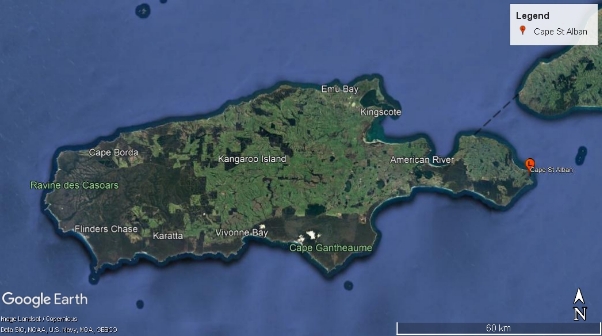
Figure 3. Kangaroo Island with Cape St. Albans Lighthouse on east coast (Image: Landsat/Copernicus, Data: SIO, NOAA, U.S. Navy, NGA, GEBCO)

Figure 4. Cape St Albans on eastern coast of Kangaroo Island (Image: ©2022 TerraMetrics, ©2022 CNES/Airbus, Data: SIO, NOAA, U.S Navy, NGA, GEBCO)
2.2 Setting and landscape
Cape St Albans is a relatively bare, flat promontory that forms the most eastern point of Kangaroo Island. Jagged cliffs form the edge of the cape which abuts Backstairs Passage.
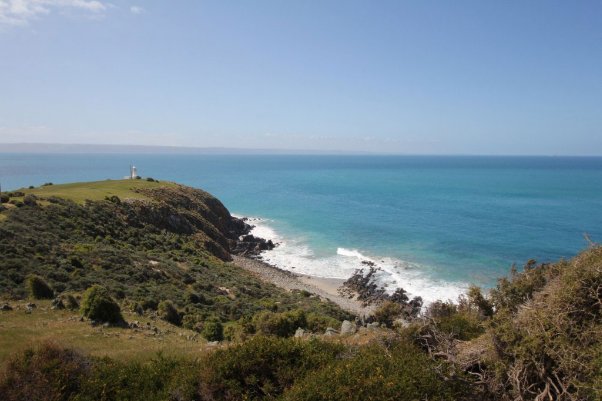 Figure 5. View of Cape St Albans landscape and tower (© AMSA, 2014)
Figure 5. View of Cape St Albans landscape and tower (© AMSA, 2014)
Fauna and flora
A quarter of Kangaroo Island’s landmass is conserved within conservation parks, national parks and wilderness protection areas. The island is also void of pests such as rabbits and foxes due to its isolation.
The following faunal species are native to the island:
- Kangaroo Island western grey kangaroo (macropus fuliginosus fuliginosus)
- Rosenberg’s sand goanna (Varanus rosenbergi)
- Southern brown bandicoot (isoodon obesulus)
- Tammar wallaby (macropus eugenii)
- Common brushtail possum (trichosurus vulpecula)
- Short-beaked echidna (tachyglossus aculeatus)
- Australian sea lion (neophoca cinerea)
- Long-nosed fur seal (arctocephalus forsteri)
The following faunal species have been introduced to the island:
- Koala (phascolarctos cinereus)
- Common ringtail possum (pseudocheirus peregrinus)
- Platypus (Ornithorhynchus anatinus)
The island has also been identified as an Important Bird Area by BirdLife International.[v]
As of 2012, the waters below Cape St Albans were included within the Habitat Protection Zone (HPZ) of the Encounter Marine Park Management Plan.[vi] A HPZ is defined in the Marine Parks Act 2007 as “a zone primarily established so that an area may be managed to provide protection for habitats and biodiversity within a marine park, while allowing activities and uses that do not harm habitats or the functioning of ecosystems”.[vii]
2.3 Site management
The lighthouse is situated within gazetted Commonwealth land. As the Commonwealth Authority, AMSA manages and maintains the lighthouse.
2.4 Access
Cape St Albans is accessible from Penneshaw via 25 kilometres of sealed roads, unsealed roads and steep rocky track that required a 4WD vehicle. Access to the tower also requires crossing through privately owned gates therefore authorised personnel only are permitted access to the site.
Due to small internal accessways and the installation of critical navigational equipment, access inside the lighthouse tower is restricted to authorised personnel and AMSA employees and contractors.
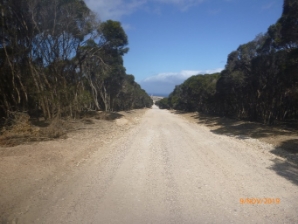
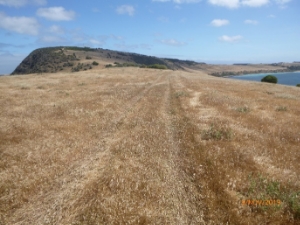
Figure 6. Unsealed road to Cape St Albans Lighthouse (© AMSA, 2019)
Figure 7. Access track to Cape St Albans Lighthouse (© AMSA, 2019)
2.5 Listings
Cape St Albans Lighthouse is listed on the following heritage registers:
List | ID |
Commonwealth Heritage List | 105413[viii] |
Register of the National Estate | 7426[ix] |

3. History
3.1 General history of lighthouses in Australia
The first lighthouse to be constructed on Australian soil was Macquarie Lighthouse, located at the entrance to Port Jackson, NSW. First lit in 1818, the cost of the lighthouse was recovered through the introduction of a levy on shipping. This was instigated by Governor Lachlan Macquarie, who ordered and named the light.
The following century oversaw the construction of hundreds of lighthouses around the country. Constructing and maintaining a lighthouse were costly ventures that often required the financial support of multiple colonies. However, they were deemed necessary aids in assisting the safety of mariners at sea. Lighthouses were firstly managed by the colony they lay within, with each colony developing their own style of lighthouse and operational system. Following Federation in 1901, which saw the various colonies unite under one Commonwealth government, lighthouse management was transferred from state hands to the Commonwealth Lighthouse Service.
Lamps and optics: an overview
Lighthouse technology has altered drastically over the centuries. Eighteenth century lighthouses were lit using parabolic mirrors and oil lamps. Documentation of early examples of parabolic mirrors in the United Kingdom, circa 1760, were documented as consisting of wood and lined with pieces of looking glass or plates of tin. As described by Searle, ’When light hits a shiny surface, it is reflected at an angle equal to that at which it hit. With a light source is placed in the focal point of a parabolic reflector, the light rays are reflected parallel to one another, producing a concentrated beam’.[x]
In 1822, Augustin Fresnel invented the dioptric glass lens. By crafting concentric annular rings with a convex lens, Fresnel had discovered a method of reducing the amount of light absorbed by a lens. The Dioptric System was adopted quickly with Cordouran Lighthouse (France), which was fitted with the first dioptric lens in 1823. The majority of heritage-listed lighthouses in Australia house dioptric lenses made by others such as Chance Brothers (United Kingdom), Henry-LePaute (France), Barbier, Bernard & Turenne (BBT, France) and Svenska Aktiebolaget Gasaccumulator (AGA of Sweden). These lenses were made in a range of standard sizes, called orders—see ‘Appendix 2. Glossary of lighthouse Terms relevant to Cape St Albans Lighthouse’.
Early Australian lighthouses were originally fuelled by whale oil and burned in Argand lamps, and multiple wicks were required in order to create a large flame that could be observed from sea. By the 1850s, whale oil had been replaced by colza oil, which was in turn replaced by kerosene, a mineral oil.
In 1900, incandescent burners were introduced. This saw the burning of fuel inside an incandescent mantle which produced a brighter light with less fuel within a smaller volume. Light keepers were required to maintain pressure to the burner by manually pumping a handle as can be seen in Figure 8.

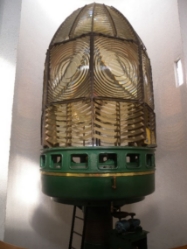
Figure 8. Incandescent oil vapour lamp by Chance Brothers (Source: AMSA)
Figure 9. Dioptric lens on display at Narooma (Source: AMSA)
In 1912, Swedish engineer Gustaf Dalén, was awarded the Nobel Prize in physics for a series of inventions relating to acetylene-powered navigation lights. Dalén’s system included the sun valve, the mixer, the flasher, and the cylinder containing compressed acetylene. Due to their efficiency and reliability, Dalén’s inventions led to the gradual de-staffing of lighthouses. Acetylene was quickly adopted by the Commonwealth Lighthouse Service from 1915 onwards.
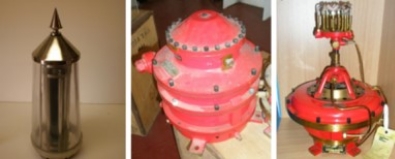
Figure 10. Dalén's system - sunvalve, mixer and flasher (Source: AMSA)
Large dioptric lenses, such as that shown in Figure 9, gradually decreased in popularity due to cost and the move towards unmanned automatic lighthouses. By the early 1900s, Australia had stopped ordering these lenses with the last installed at Eclipse Island in Western Australia in 1927. Smaller Fresnel lenses continued to be produced and installed until the 1970s when plastic lanterns, still utilising Fresnel’s technology, were favoured instead. Acetylene remained in use until it was finally phased out in the 1990s.
In the current day, Australian lighthouses are lit and extinguished automatically using mains power, diesel generators, and solar-voltaic systems.
3.2 The Commonwealth Lighthouse Service
When the Australian colonies federated in 1901, they decided that the new Commonwealth government would be responsible for coastal lighthouses—that is, major lights used by vessels travelling from port to port—but not the minor lights used for navigation within harbours and rivers. There was a delay before this new arrangement came into effect. Existing lights continued to be operated by the states.
Since 1915, various Commonwealth departments have managed lighthouses. AMSA, established under the Australian Maritime Safety Authority Act 1990, is now responsible for operating Commonwealth lighthouses and other aids to navigation, along with its other functions.
3.3 Cape St Albans: A history
Aboriginal history
Kangaroo Island has an extensive history, and the island is embedded in the Ngurunderi Dreaming Story.
Ngurunderi, an ancestral being, chased two of his wives along the coastline of Encounter Bay. When they tried to cross the waters to Kangaroo Island, Ngurunderi made the ocean rise and flood what is now known as Backstairs Passage. His wives were drowned and became the Pages Islands. Ngurunderi then travelled to Kangaroo Island where, at the far end of the island at Admiral’s Arch, he threw his spears down into the sea which created the Casuarina Islets. Ngurunderi then cleansed himself in the ocean before passing into the spirit world.
More than 100 cultural heritage sites, which include stone artefact scatters, have been uncovered on the island, and radiocarbon dating undertaken on the western end of the island demonstrated the presence of Aboriginal groups for thousands of years.
Sally, also known as Kalinga and Princess Con, is a notable figure in the history of the island. Sally was the daughter of King Condoy, the headman of Ramindjeri. In the late 1820s, Sally was taken from her home in Cape Jervis by sealers to King George Sound, and then onto Kangaroo Island by the early 1830s. She later married William Walker and had two sons, George and Joseph who were both born on the island.
Early European history
Kangaroo Island was first sighted by British explorer Matthew Flinders aboard the HMS Investigator on 23 March 1802. Flinders had landed on the north coast of Dudley Peninsula and, after noting the large number of western grey kangaroo present, named the landmass ‘Kangaroo Island’.[xi] The island was later circumnavigated and mapped by French explorer Commander Nicolas Baudin.
Kangaroo Island hosted a community of sealers from 1802 to South Australia’s colonisation in 1836. Some gangs of sealers reportedly kidnapped a number of Aboriginal women from both Tasmania and South Australia. It is understood that on a number of occasions, kidnapped women would attempt to escape by swimming across the passage between the island and the mainland. This tragically resulted in the deaths of many.[xii]
In 1836, the First Fleet of South Australia reportedly stopped in at the island’s Nepean Bay en route to the mainland. These ships, such as the Duke of York, the Lady Mary Pelham, and the Africaine, carried the first European settlers that would establish the city of Adelaide and the colony of South Australia. The first colonial settlement on Kangaroo Island was Kingscote (originally Reeves Point) established in July 1836.[xiii]
The 1840s saw the operation of whaling stations on the island’s coastline. Shipping around Kangaroo Island also grew exponentially during this time period as the island sat on either side of the Backstairs Passage and the Investigator Strait, two key shipping routes. Increased shipping led to many instances of shipwrecks around the island, which in turn led to the construction of lighthouses: Cape Willoughby in 1852 and Cape Borda in 1858.
Why Cape St Albans
A number of shipwrecks had occurred within Backstairs Passage since the mid-1850s, and a lighthouse at Cape Jervis on the mainland had been constructed in 1871 in an attempt to aid vessels.[xiv] Following the turn of the century, calls for the erection of an additional light gathered momentum.[xv] In 1905, South Australian authorities readdressed concerns for the safety of vessels traversing the passage, and it was debated whether a new light was to be constructed, or whether Cape Jervis Lighthouse should be upgraded. Talks of constructing a new staffed light were put to bed when it was determined to be far too expensive. However, advances in technology at the time meant there was the option of constructing an unstaffed, automatic light.[xvi]
Cape St Alban’s was chosen as the appropriate site for the new unstaffed light due to its prominent position in the south-east of the passage. It was determined that a light on the cape would alert vessels to ’an obstruction known as the Scraper‘, and also provide navigators ’another bearing’.[xvii]
3.4 Building a lighthouse
Design and construction
Choosing to erect an unstaffed, automatic light meant that the design for the lighthouse was relatively simple and did not require the inclusion of any keepers’ cottages. The tower was designed to be a small, circular stone structure fitted with a self-contained lantern on an open plan (see Figure 11).
Tenders for the construction of the light were first called in early 1908, however fresh tenders were called once more in April of the same year.[xviii] A self-contained lantern manufactured by Barbier, Bernard and Turenne in France was ordered and installed. It is understood that the construction of the light progressed faster than anticipated. The Register (Adelaide) newspaper reported that:
Although the original notice to mariners concerning the Cape St Albans light, in Backstairs Passage, was that it would be exhibited for the first time on or about December 1, the President of the Marine Board decided that it should be shown for the first time on Thursday night. Better progress was made with the erection of the lantern and its adjustment than was expected, hence the reason for utilizing it earlier than first arranged.[xix]
Cape St Albans Lighthouse was lit for the first time on 20 November 1908. The total cost of the lighthouse’s construction and equipment was £897.[xx]

Figure 11. Design plan of Cape St. Albans Lighthouse, signed by Engineer-in-Chief 17 March 1908. NAA: A10182, CN 01 185 (© Commonwealth of Australia, National Archives of Australia)
Equipment when built
Upon completion, Cape St Alban’s Lighthouse stood as a nine-metre, white masonry tower fitted with an unenclosed white, 4th order, fixed light.[xxi] A red sector light was also installed to shine over ‘the Scraper’. The Register newspaper reported the tower had a focal plane of 120-feet, and the light was visible for approximately 17 miles.[xxii] Powered by kerosene, the tower was originally visited once every two days by the headkeeper of Cape Willoughby Lighthouse. By 1912, the responsibility of maintaining the light was transferred to a local resident of Antechamber Bay who visited the lighthouse once a day until 1914.[xxiii]
Cape St Albans Lighthouse was one of the first three automatic lights that were constructed in South Australia following the turn of the century. Six additional automatic lights were constructed prior to when the Commonwealth Government assumed the responsibility for all coastal lights around the country in 1915.[xxiv]
3.5 Chronology of major events
The following table details the major events to have occurred at Cape St Albans Lighthouse.
Date | Event |
20 November 1908 | Cape St Albans Lighthouse lit for first time. |
1912 | Local resident of Antechamber Bay employed with checking the lighthouse once a day.[xxv] C.R.W. Brewis visits Cape St Albans Lighthouse.[xxvi] |
1914 | Daily visits to the lighthouse cease.[xxvii] |
1931 | Lighthouse steamer the Lady Loch visits Cape St Albans Lighthouse.[xxviii] |
25 January 1955 | Schooner the Grelka wrecked near Cape St Alban.[xxix] |
3.6 Changes and conservation over time
The following section details the changes and conservation efforts to have been carried out at Cape St Albans Lighthouse since its construction.
The Brewis Report
Commander CRW Brewis, retired naval surveyor, was commissioned in 1911 by the Commonwealth Government to report on the condition of existing lights and to recommend any additional ones. Brewis visited every lighthouse in Australia between June and December 1912, and produced a series of reports published in their final form in March 1913. These reports were the basis for decision-making for the individual lighthouses and provide a snapshot of the lighthouse in the early twentieth century.
Brewis recommended that the Cape St Albans Lighthouse be discontinued.[xxx]
Cape St Alban Light (U.) (72 miles from Adelaide ; 2 ½ from Cape Willoughby.) Lat. 35° 49’ S., Long. 138° 07’ E., Charts Nos. 1014 and 25. – Established 1908. Character. – One white, with red sector. (U.) Fixed, diptric, 4th order, - w., about 800 c.p.; r., about 200 c.p. Illuminant, kerosene. Visibility. – Shows red through an arc of 84 degrees from 264 ½ (S. 79 W. Mag.) to 368 ½ (N. 17 W., Mag.); white elsewhere. Visible in clear weather – white, 14; red, 6 nautical miles. Optical Apparatus. – Barbier, Bernard, and Turenne, 1907. Fixed lens. Focal radius, 9 inches. Condition and State of Efficacy. – The tower and apparatus are in good condition. No keeper is stationed at the light. It is visited once a day by a resident of Antechamber Bay, distant about 5 miles, who receives remuneration for this duty. Life-saving equipment is kept at farm in this vicinity. It was previously stored at Cape Willoughby. Communication. – Visited once or twice a year by Government steamer. Fogs. – Fogs are experienced February-March, and June-July. RECOMMENDED. – This light be discontinued, and placed at Cape Willoughby as a subsidiary light, showing a red sector over the Scraper Shoal. This, together with an automatic (U.) light on North Page Island, and a light buoy on Yatala Shoal, will provide for the navigation of Backstairs Passage. |
Alteration to the light
The following table details the changes to the Cape St Albans light since its exhibition in 1908.
Date | Alteration |
1908 | Tower installed with fixed Barbier, Bernard and Turenne lantern, fuelled by kerosene. |
14 August 1914 | Converted from kerosene to automatic acetylene. Character of light altered from fixed, to group flashing.[xxxi] |
1915 | Barbier, Bernard and Turenne lens and equipment replaced, Chance Bros. lens, AGA flasher and sunvalve installed. Light enclosed with small drum lantern house.[xxxii] |
1970 | Intensity: 890 cd |
1976 | Light connected to mains electricity.[xxxiii] Lamp a 1000W 120V tungsten halogen. Intensity: 28,000 cd. |
1990 | Intensity: 12,800 cd. |
For information on current light details, see ‘Appendix 4 Cape St Albans Lighthouse current light details’.
Recent conservation works
The following table details the recent conservation works to have occurred at Cape St Albans Lighthouse.
Date | Work |
2006 | Balcony access ladder and handrails removed. New stainless steel framed balcony and access stairs with FRP grating, and handrails installed. Concrete apron and fence extended. |
2011 | Compound fence repairs. |
2016 | Partial perimeter fencing replacements installed on north-western side following storm damage. |
3.7 Summary of current and former uses
From its construction in 1908, Cape St Albans Lighthouse has been used as a marine AtoN for mariners at sea. Its AtoN capability remains its primary use.
3.8 Summary of past and present community associations
Aboriginal associations
The Ramindjeri Heritage Association Inc. draw direct connection to King Condoy, headman of Ramindjeri, and Princess Con. Ramindjeri people observe the island to be a ‘gateway to heaven’, and maintain strong ties to the island
Local, national and international associations
Cape St Albans Lighthouse is considered a significant site of South Australian and Australian history. The cape and lighthouse maintain strong familial associations due to the lighthouse’s history as a locally-maintained site.
3.9 Unresolved questions or historical conflicts
Any unresolved questions or historical conflicts uncovered will be highlighted within this section in future versions of this plan.
3.10 Recommendations for further research
Archaeological investigation of the site may reveal further information on prehistoric and historic uses of Cape St Albans to broaden understanding of the site’s intrinsic value.

4. Fabric
4.1 Fabric register
The cultural significance of the lighthouse resides in its fabric, and also in its intangible aspects, such as the meanings people ascribe to it, and the connections to other places and things. The survival of its cultural value depends on a well-informed understanding of what is significant, and on clear thinking about the consequences of change. The Burra Charter sets out good practice for conserving cultural significance.
Below, each part of the lighthouse is listed and the description, condition and significance of each part is discussed. Criterion listed under ‘Heritage Significance’ refer to the criterion satisfied within the specific Commonwealth heritage listing (see ‘Section 5.1’).
Lighthouse feature: Lantern roof


 © AMSA 2020
© AMSA 2020
Description and condition
Conical roof of copper sheets lapped and bolted. Built with single skin (no internal lining). Supported on circular ring of cast iron segments bolted together.
- Ventilator – ball shaped vent, with circular internal insect mesh.
- Lightning conductor – single spike with trident on top of vent.
- Gutter – none.
Finish | painted |
Condition | intact and sound |
Significance | high |
Integrity | high |
Maintenance | keep in service, prepare and repaint at normal intervals |
Rectification works | none |
Heritage significance: High
The lantern roof forms part of a lighthouse, which was integral to South Australia’s growth of navigational assistance during the early twentieth century (criterion a).
The lantern roof forms part of one of South Australia’s earliest unattended lighthouses (criterion f).
Lighthouse feature: Lantern glazing

 © AMSA 2020
© AMSA 2020
Description and condition
Cylindrical in form.
- Panes – curved, trapezoidal glass panes, single tier. Landward sector masked by sheet of curved material fitted inside the astragals.
- Astragals – cast iron, bolted to roof support ring at top and to lantern base at bottom.
Finish | glass: clear other parts: painted |
Condition | intact and sound |
Significance | high |
Integrity | high |
Maintenance | keep in service, reglaze as necessary, prepare and repaint at normal intervals |
Rectification works | none |
Heritage significance: High
The lantern glazing forms part of a lighthouse, which was integral to South Australia’s growth of navigational assistance during the early twentieth century (criterion a).
The lantern glazing forms part of one of South Australia’s earliest unattended lighthouses (criterion f).
Lighthouse feature: Lantern base
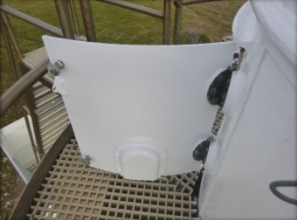
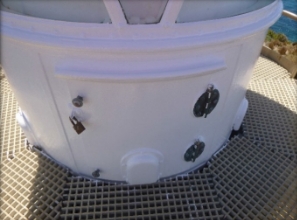
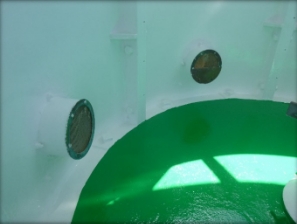 © AMSA 2020
© AMSA 2020
Description and condition
Chance Bros, cylindrical in form. Curved panels of cast iron bolted together with flanged joints. No internal lining (removed).
- Vents – cast iron cowls outside, one in each panel. Round tube protruding inside from each vent, covered with stainless mesh and half covered with metal plate.
- Door – Replica Chance Bros iron door with copper alloy hinges and thumbscrew fasteners.
Finish | painted |
Condition | intact and sound |
Significance | high |
Integrity | high |
Maintenance | keep in service, prepare and repaint at normal intervals |
Rectification works | none |
Heritage significance: High
The lantern base forms part of a lighthouse, which was integral to South Australia’s growth of navigational assistance during the early twentieth century (criterion a).
The lantern base forms part of one of South Australia’s earliest unattended lighthouses (criterion f).
Lighthouse feature: Lantern floor

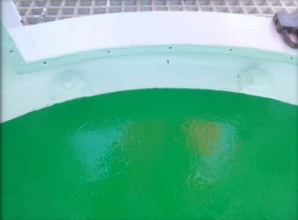
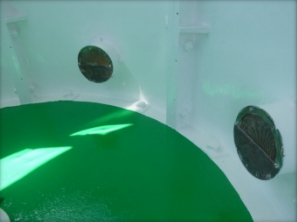 © AMSA 2020
© AMSA 2020
Description and condition
Concrete slab, continuous with balcony floor and cornice.
Finish | painted |
Condition | intact and sound |
Significance | high |
Integrity | high |
Maintenance | keep in service, prepare and repaint at normal intervals |
Rectification works | none |
Heritage significance: High
The lantern floor forms part of a lighthouse, which was integral to South Australia’s growth of navigational assistance during the early twentieth century (criterion a).
The lantern floor forms part of one of South Australia’s earliest unattended lighthouses (criterion f).
Lighthouse feature: Lens assembly
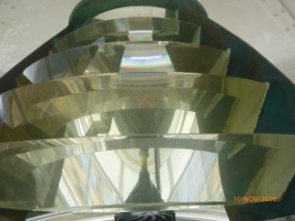
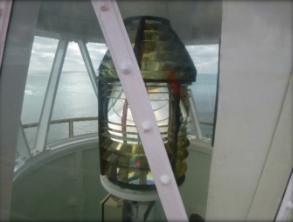
© AMSA 2020
Description and condition
250mm focal radius fixed (non-rotating) lens assembly of glass and gunmetal.
Finish | painted |
Condition | intact and sound |
Significance | high |
Integrity | high |
Maintenance | clean at regular intervals |
Rectification works | none |
Heritage significance: High
The lens assembly forms part of a lighthouse, which was integral to South Australia’s growth of navigational assistance during the early twentieth century (criterion a).
The lens assembly forms part of one of South Australia’s earliest unattended lighthouses (criterion f).
Lighthouse feature: Light source
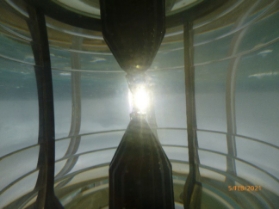 © AMSA 2021
© AMSA 2021
Description and condition
Sealite SL-LED-216-W.
Condition | sound |
Significance | low |
Integrity | high |
Maintenance | keep in service |
Rectification works | none |
Heritage significance: Low
The light source is of low significance.
Lighthouse feature: Pedestal

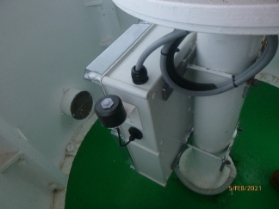
© AMSA 2021
Description and condition
Cast iron post with fixed circular table on top. Flasher and other control gear mounted in metal box attached to pedestal.
Finish | painted |
Condition | intact and sound |
Significance | pedestal and table: high other parts: low |
Integrity | high |
Maintenance | keep in service, prepare and repaint at normal intervals |
Rectification works | none |
Heritage significance: High
The pedestal forms part of a lighthouse, which was integral to South Australia’s growth of navigational assistance during the early twentieth century (criterion a).
The pedestal forms part of one of South Australia’s earliest unattended lighthouses (criterion f).
Lighthouse feature: Balcony floor
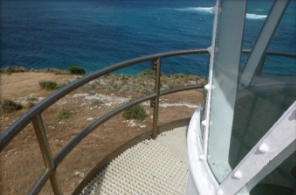
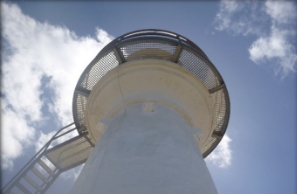

 © AMSA 2020
© AMSA 2020
Description and condition
Recent stainless steel structure with FRP mesh c2006 fixed over 1908 concrete slab, which is continuous with lantern floor and coved cornice and string course.
Finish | stainless steel: bare metal, FRP coloured mesh membrane painted over concrete slab. |
Condition | intact and sound |
Significance | original concrete floor: high stainless steel and FRP: low |
Integrity | low |
Maintenance | stainless steel and FRP materials require little maintenance maintain membrane over original balcony slab |
Rectification works | none |
Heritage significance: High
The concrete component of the balcony floor is an original part of a lighthouse, which was integral to South Australia’s growth of navigational assistance during the early twentieth century (criterion a).
The concrete component of the balcony floor is an original part of one of South Australia’s earliest unattended lighthouses (criterion f).
Lighthouse feature: Balcony balustrade


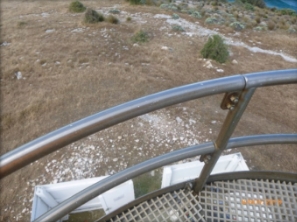 © AMSA 2019
© AMSA 2019
Description and condition
Stainless steel circular hollow section stanchions, handrails and knee-rails; stainless steel kick-plate.
Finish | bare metal |
Condition | intact and sound |
Significance | low |
Integrity | low |
Maintenance | keep in service, monitor condition |
Rectification works | none |
Heritage significance: Low
The recent stainless steel balustrades are of low significance.
Lighthouse feature: Walls

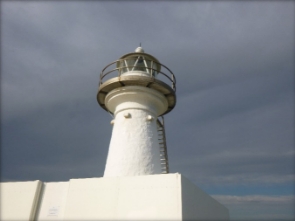
© AMSA 2020
Description and condition
1908 small conical tower of stone rubble masonry roughly rendered inside and out, with plinth at the bottom. Cast iron vents fitted around the walls, below the cornice.
- Vents – original vents were corroded beyond economical repair. Original covers were replaced with FRP covers, a non-corrosive substitute
Finish | painted |
Condition | intact and sound |
Significance | vent covers: low other features: high |
Integrity | high |
Maintenance | keep in service, prepare and repaint at normal intervals |
Rectification works | none |
Heritage significance: High
The walls are an original part of a lighthouse, which was integral to South Australia’s growth of navigational assistance during the early twentieth century (criterion a).
The walls are an original part of one of South Australia’s earliest unattended lighthouses (criterion f).
Lighthouse feature: External ladder

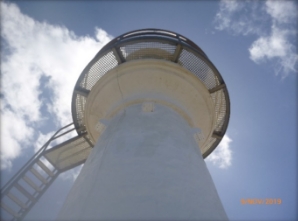 © AMSA 2019
© AMSA 2019
Description and condition
Fixed ladder from ground to balcony. Stainless steel stiles and FRP treads. Stainless steel brackets fixing the ladder to the ground and to the balcony. (This stainless steel ladder replaces an earlier timber ladder, which was a replacement for the original iron ladder shown on the 1908 drawings.)
Finish | bare metal |
Condition | intact and sound |
Significance | low |
Integrity | low |
Maintenance | keep in service, monitor condition |
Rectification works | none |
Heritage significance: Low
The recent stainless steel external ladder is of low significance.
Lighthouse feature: Door
 © AMSA 2019
© AMSA 2019
Description and condition
Early timber framed and sheeted door hung in timber frame on butt hinges. Recent stainless steel louvre vent panel fitted between mid-rail and bottom rail. Secured with pad bolt and CLS padlock.
Finish | louvres: bare stainless steel other parts: unpainted |
Condition | intact and sound |
Significance | door: high louvre: low |
Integrity | high |
Maintenance | keep in service, prepare and repaint at normal intervals |
Rectification works | none |
Heritage significance: High
The door forms part of a lighthouse, which was integral to South Australia’s growth of navigational assistance during the early twentieth century (criterion a).
The door forms part of one of South Australia’s earliest unattended lighthouses (criterion f).
Lighthouse feature: Ground floor
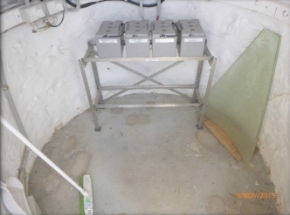 © AMSA 2019
© AMSA 2019
Description and condition
Finish | painted |
Condition | intact and sound |
Significance | high |
Integrity | high |
Maintenance | prepare and repaint at normal intervals |
Rectification works | none |
Concrete slab on ground.
Heritage significance: High
The ground floor is an original part of a lighthouse, which was integral to South Australia’s growth of navigational assistance during the early twentieth century (criterion a).
The ground floor is an original part of one of South Australia’s earliest unattended lighthouses (criterion f).
Lighthouse feature: Equipment


© AMSA 2021
Description and condition
Equipment installed inside the tower at ground floor level: four batteries on galvanised steel rack; battery charger; cabling; control gear.
Condition | sound |
Significance | low |
Integrity | high |
Maintenance | none |
Rectification works | none |
Heritage significance: Low
The equipment is of low significance.
Lighthouse feature: Apron paving
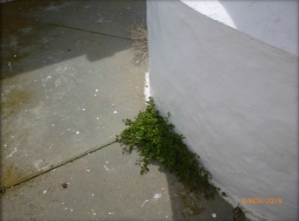
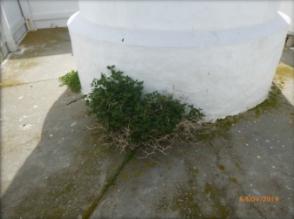 © AMSA 2019
© AMSA 2019
Description and condition
Concrete paving around the base of the tower, to the full extent of the fenced area.
Finish | bare concrete |
Condition | intact and sound |
Significance | moderate |
Integrity | high |
Maintenance | keep in service, carry out minor repairs as required |
Rectification works | none |
Heritage significance: Moderate
The modified paving forms part of a lighthouse, which was integral to South Australia’s growth of navigational assistance during the early twentieth century (criterion a).
The modified paving forms part of one of South Australia’s earliest unattended lighthouses (criterion f).
Lighthouse feature: Fence


© AMSA 2020
Description and condition
1908 timber framed fence, extensively rebuilt. Several original posts remain, with evidence of the original arris-cut rails housed into the posts. Most of the posts and all of the rails, are later replacements. The original corrugated iron sheeting was replaced with a ‘super six’ corrugated asbestos-cement. The corrugated asbestos–cement sheet has recently been replaced with a fibre-cement flat sheeting. Timber-framed gate, sheeted with fibre-cement sheet. Storm damaged section of fence on north western side completely replaced in 2016.
Finish | painted |
Condition | intact and sound |
Significance | moderate |
Integrity | low |
Maintenance | keep in service, prepare and repaint at normal intervals |
Rectification works | none |
Heritage significance: Moderate
The modified fence forms part of a lighthouse, which was integral to South Australia’s growth of navigational assistance during the early twentieth century (criterion a).
The modified fence forms part of one of South Australia’s earliest unattended lighthouses (criterion f).
4.2 Related object and associated AMSA artefacts
There are currently no AMSA artefacts stored at Cape St Albans Lighthouse.
4.3 Comparative analysis
Cape St Albans Lighthouse was one of three unattended lights built along the South Australian coast at the turn of the twentieth century. The other two were the Eastern Shoal Light in Spencer Gulf in 1902, and Cape Donington Light in 1905. The three lighthouses varied in design, but were fitted with similar technologies in order to allow for automatic operation.[xxxiv]

5. Heritage significance
5.1 Commonwealth heritage listing – Cape St Albans Lighthouse
The following information is taken directly from the Commonwealth Heritage listing for Cape St Albans Lighthouse (Place ID: 105413)[xxxv]
Commonwealth statement of significance
The following statement of significance is taken directly from Cape St Albans Lighthouse’s Commonwealth heritage listing:
Historically, Cape St Alban Lighthouse is one of the earliest purpose built unattended lights established in South Australia. It was built during a period of transition in lighthouse technology when Australian maritime authorities and the South Australian Marine Board in particular, began to experiment with automatic illumination systems (Criterion F1).
Cape St Alban Lighthouse formed part of a comprehensive system of coastal lighting established by the South Australian Marine Board before the Commonwealth Government assumed functional responsibility in 1915. Together with the other lights on Kangaroo Island, Cape St Alban Lighthouse continues to play an important role in providing navigational assistance to shipping serving Adelaide and other coastal centres in the region (Criterion A4).
Commonwealth heritage criteria
There are nine criteria for inclusion in the Commonwealth Heritage List, meeting any one of these is sufficient for listing a place. These criteria are similar to those used in other Commonwealth, state and local heritage legislation, although thresholds differ. In the following sections, Cape St Albans Lighthouse is discussed in relation to each of the criteria as based on the site’s current Commonwealth Heritage Listing (Place ID: 105413)
Criterion | Attributes | Explanation |
Criterion A) Processes This criterion is satisfied by places that have significant heritage value because of [their] importance in the course, or pattern, of Australia’s natural or cultural history. | The whole of the lighthouse including tower, curtilage and modified optics. | Cape St Alban Lighthouse formed part of a comprehensive system of coastal lighting established by the South Australian Marine Board before the Commonwealth Government assumed functional responsibility in 1915. Together with the other lights on Kangaroo Island, Cape St Alban Lighthouse continues to play an important role in providing navigational assistance to shipping, serving Adelaide and other coastal centres in the region. |
Criterion F) Technical achievement This criterion is satisfied by places that have significant heritage value because of [their] importance in demonstrating a high degree of creative or technical achievement at a particular period. | The whole of the lighthouse including tower, curtilage and modified optics. | Cape St Alban Lighthouse is one of the earliest purpose-built, unattended lights established in South Australia. It was built during a period of transition in lighthouse technology when Australian maritime authorities and the South Australian Marine Board in particular, began to experiment with automatic illumination systems. |
These heritage values, identified and explained in the Commonwealth Heritage List, will form the basis of the management of Cape St Albans Lighthouse. In the event of necessary works, all criteria will be consulted to inform best practice management of the values associated with the lighthouse. (See ‘Section 7. Conservation management policies’ for further information on strategies to conserve heritage values of Cape St Albans Lighthouse).
5.2 Condition and integrity of Commonwealth heritage values
A heritage-monitoring program was implemented in 2016. Each site is visited and reviewed every two years to evaluate the heritage fabric and values of the site. Assessment of the condition and integrity of lighthouse's values are derived from the latest available Heritage asset condition report, produced by AMSA’s maintenance contractor.
‘Condition’ is measured from Good-Sound-Poor and incorporates the current condition of the specific value. Integrity is measured from High-Medium-Low and incorporates the value’s intactness. Cape St Albans Lighthouse’s Commonwealth heritage values and its associated attributes, maintain good condition and high integrity.
Value | Attributes | Condition | Integrity |
Criterion A) Processes | The whole of the lighthouse including tower, curtilage and modified optics. | Good | High |
Criterion E) Aesthetic value | The whole of the lighthouse including tower, curtilage and modified optics. | Good | High |
5.3 Gain or loss of Commonwealth heritage values
Evidence for the potential gain or loss of heritage values will be documented within this section in future versions of the plan.

6. Opportunities and constraints
6.1 Implications arising from significance
The Commonwealth statement of significance (section 5.1 above) demonstrates Cape St Albans Lighthouse is a place of considerable heritage value due to its contribution to navigational assistance as one of the earliest unattended lights established in South Australia.
The implication arising from this assessment is that key aspects of the place should be conserved to retain this significance. The key features requiring conservation include:
- continued use of the lighthouse as an AtoN
- architectural quality of the building
- interior spaces and features, which are notable for their design, details and/or their original lighthouse function. These include:
- lantern room
- lens assembly
- ground floor
- external spaces and features, which are notable for their design, details, and/or their original lighthouse function. These include:
- lantern roof and glazing
- balcony
- walls
- external ladder
- door
- apron paving
- fence.
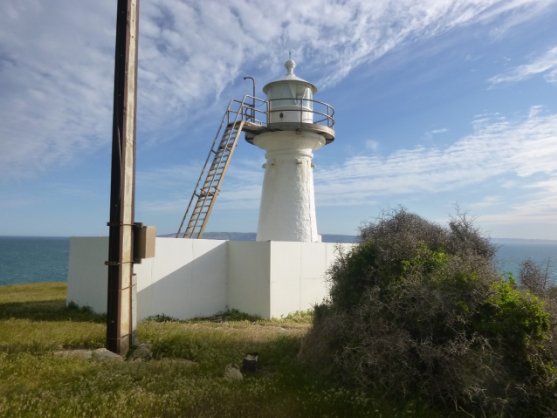
Figure 12. Cape St Albans Lighthouse site (© AMSA, 2018)
Referral and approvals of action
The EPBC Act requires approval from the Minister for the Environment for all actions likely to have a significant impact on matters of National Environmental Significance (NES).
The Act provides that actions taken:
- on Commonwealth land, which are likely to have a significant impact on the environment, will require approval of the Minister.
- outside Commonwealth land, which are likely to have a significant impact on the environment on Commonwealth land, will require approval of the Minister.
- by the Australian Government or its agencies, which are likely to have a significant impact on the environment anywhere, will require approval of the Minister.
The definition of ‘environment’ in the EPBC Act and EPBC Regulations includes the cultural heritage values of places.
Heritage strategy
If an Australian Government agency owns or controls one or more places with Commonwealth heritage values, it must prepare a heritage strategy within two years from the first time they own or control a heritage place (section 341ZA).
A heritage strategy is a written document that integrates heritage conservation and management within an agency’s overall property planning and management framework. Its purpose is to help an agency manage and report on the steps it has taken to protect and conserve the commonwealth heritage values of the properties under its ownership or control.
The heritage strategy for AMSA’s AtoN assets was completed and approved by the Commonwealth Minister for the Environment in 2018 and reviewed in 2022. The latest version of the Strategy is available online.P37F[xxxvi]
Heritage asset condition report
A heritage asset condition report is a written document that details the heritage of a site with an in-depth description of each architectural and structural element. The document includes: a brief history of the site, the Commonwealth Heritage statement of significance and value criteria, a heritage significance rating for each individual element, and a catalogue of artefacts on-site. The document is also accompanied by up-to-date photos of each structural element. This document operates as a tool for heritage monitoring, and is reviewed and updated biennially.
Aboriginal heritage significance and natural values
The broader Cape St Albans landscape is notable for its heritage significance and natural values. Although these values lie outside of the Commonwealth heritage listing curtilage, the potential remains for future works at the lighthouse to impact these values. At the time this plan was written, no plans have been made for future works at Cape St Albans Lighthouse. In the event major works at the lighthouse are to be carried out, AMSA will seek to minimise impacts to the surrounding area by:
- Utilising specific access tracks to ensure no damage to surrounding vegetation,
- Ensuring project footprint is limited to the AMSA curtilage. In any instance that work is required outside of this footprint, approvals will be sought from the appropriate stakeholders,
- Implementing an appropriate discovery plan in the instance Aboriginal cultural heritage is suspected and/or found.
6.2 Framework: sensitivity to change
Owing to the site’s desired intactness and aesthetic qualities, Cape St Albans Lighthouse is of high significance. Therefore, work actioned by AMSA on the lighthouse’s fabric harnesses the potential to reduce or eradicate the significance of the site’s heritage values.
Conservation works—including restoration and reconstruction, or adaptation works of the absolute minimum so as to continue the lighthouse’s usefulness as an AtoN—are the only works that should be actioned by AMSA on Cape St Albans Lighthouse. Some exceptions are made for health and safety requirements. However, any and all work carried out must be conducted in line with heritage considerations and requirements of the EPBC Act.
The table below demonstrates the level of sensitivity attributed to the various elements of the fabric register in the face of change. These are measured from high to low, depending on the action’s possible threat to the site’s heritage values.
High sensitivity
High sensitivity to change includes instances wherein a change would pose a major threat to the heritage value of a specific fabric, or the lighthouse as a whole. A major threat is one that would lead to substantial or total loss of the heritage value.
Moderate sensitivity
Moderate sensitivity to change includes instances wherein a change would pose a moderate threat to the heritage value of a specific fabric, or to the heritage significance of a specific fabric in another part of the building. A moderate threat is one that would diminish the heritage value, or diminish the ability of an observer to appreciate the value.
Low sensitivity
Low sensitivity to change includes instances wherein a change would pose little to no threat to the heritage value of a specific fabric, or to the heritage significance in another part of the building.
Component | Level of sensitivity | Nature of change impacting heritage values |
Cape St Albans Lighthouse structure | High | - Reduction of all round visibility of structure and its setting on Cape St Albans.
- Major alterations to the tower.
|
Low | - Removal of asbestos and lead paint or other toxic materials.
|
Ground floor | High | - Major alterations to concrete slab.
|
Low | - Repainting of ground floor in like colours.
- Removal or replacement of modern equipment.
|
External ladder | Low | - Corrosion reparations to ladder.
- Replacement of recent ladder.
|
Lantern room | High | - Major alterations to Chance Bros. 1914 lantern room including floor, walls and fixtures.
- Permanent removal of 1914 Chance Bros. lantern house.
|
Low | - Repainting of lantern room floor, walls and door in like colours.
- Corrosion reparations to fixtures.
- Reglazing of lantern room panes.
- Replacement of replica door.
|
Balcony | High | - Major alterations to or removal of original concrete slab floor.
|
Low | - Replacement of FRP mesh, and stainless steel balustrades.
- Corrosion reparations to balustrades.
|
Lens assembly | High | - Major alterations to cast iron pedestal and table.
|
Medium | - Removal of non-rotating lens from site.
|
Low | - Repainting of pedestal in like colours.
- Replacement of lamp-changer.
- Cleaning of non-rotating lens.
- Alteration of light’s character.
|
Lantern roof | High | |
Medium | - Adding of attachment to lantern roof.
|
Low | - Corrosion reparations to lantern roof.
- Repainting of lantern roof in like colours.
|
Walls | High | - Major alterations to original stone rubble masonry walls.
|
Low | - Repainting of tower walls in like colours.
- Corrosion reparations to vents.
- Replacement of modern vent fixtures
|
Door | High | - Major alterations to the early timber framed and sheeted door.
|
Low | - Repainting of door in like colours.
- Corrosions reparations to louvre.
|
Apron paving | High | - Major alterations to concrete paving.
|
Low | - Carry out minor repairs to concrete paving.
- Vegetation control around apron paving.
|
Timber fence | High | - Removal of original fence posts.
- Removal of original arris-cut rails.
|
Low | - Reparations to posts, rails and fibre-cement flat sheeting.
- Replacement of rails and fibre-cement sheeting.
- Repainting of fence in like colours.
- Vegetation control around fence.
|
6.3 Statutory and legislative requirements
The following table lists the Acts and codes relevant to the management of Cape St Albans Lighthouse.
Act or code | Description |
Environment Protection and Biodiversity Conservation Act 1999 (Cth) | The Environment Protection & Biodiversity Conservation Act 1999 (Cth) requires agencies to prepare management plans that satisfy the obligations included in Schedule 7A and 7B of the EPBC Regulations. |
Environment Protection and Biodiversity Conservation Regulations 2000 (Cth) Schedule 7B | The Commonwealth Department of Climate Change, Energy, the Environment and Water has determined these principles as essential for guidance in managing heritage properties. - The objective in managing Commonwealth Heritage places is to identify, protect, conserve, present and transmit, to all generations, their Commonwealth Heritage values.
- The management of Commonwealth Heritage places should use the best available knowledge, skills and standards for those places, and include ongoing technical and community input to decisions and actions that may have a significant impact on their Commonwealth Heritage values.
- The management of Commonwealth Heritage places should respect all heritage values of the place and seek to integrate, where appropriate, any Commonwealth, state, territory and local government responsibilities for those places.
- The management of Commonwealth Heritage places should ensure that their use and presentation is consistent with the conservation of their Commonwealth Heritage values.
- The management of Commonwealth Heritage places should make timely and appropriate provision for community involvement, especially by people who:
(a) have a particular interest in, or associations with, the place; and (b) may be affected by the management of the place; - Indigenous people are the primary source of information on the value of their heritage and that the active participation of indigenous people in identification, assessment and management is integral to the effective protection of indigenous heritage values.
- The management of Commonwealth Heritage places should provide for regular monitoring, review and reporting on the conservation of Commonwealth Heritage values.
|
AMSA Heritage Strategy 2022-2025 | As the custodian of many iconic sites, the Australian Maritime Safety Authority (AMSA) has long recognised the importance of preserving their cultural heritage. This Heritage Strategy is in response to section 341ZA of the EPBC Act (1999) which obliges AMSA to prepare and maintain a heritage strategy, along with obliging AMSA to: - Assist in identification, assessment and monitoring of places of heritage value in its care;
- Prepare and maintain a register of its places of heritage value;
- Protect the heritage value of places when they are sold or leased;
- Provide this heritage strategy, and any subsequent major updates, to the relevant minister.
The strategy derives from the AMSA Corporate Plan and achievements are reported through the AMSA Annual Report. The 2021-22 AMSA Annual report can be found online.[xxxvii] |
Navigation Act 2012 (Cth) | Part 5 of the Act outlines AMSA’s power to establish, maintain and inspect marine aids to navigation (such as Cape St Albans Lighthouse). (1) AMSA may: (a) establish and maintain aids to navigation; and (b) add to, alter or remove any aid to navigation that is owned or controlled by AMSA; and (c) vary the character of any aid to navigation that is owned or controlled by AMSA. (2) AMSA, or person authorised in writing by AMSA may, at any reasonable time of the day or night: (a) inspect any aid to navigation or any lamp or light which, in the opinion of AMSA or the authorised person, may affect the safety or convenience of navigation, whether the aid to navigation of the lamp or light is the property of: (i) a state or territory; or (ii) an agency of a state or territory; or (iii) any other person; and (b) enter any property, whether public or private, for the purposes of an inspection under paragraph (a); and (c) transport, or cause to be transported, any good through any property, whether public or private, for any purpose in connection with: (i) the maintenance of an aid to navigation that is owned or controlled by AMSA; or (ii) the establishment of any aid to navigation by AMSA. |
Australian Heritage Council Act 2003 (Cth) | This Act establishes the Australian Heritage Council, whose functions are: - to make assessments under Division 1A and 3A of Part 15 of the EPBC Act 1999;
- to advise the Minister on conserving and protecting places included, or being considered for inclusion, in the National Heritage List or Commonwealth Heritage List;
- to nominate places for inclusion in the National Heritage List or Commonwealth Heritage List;
- to promote the identification, assessment, conservation and monitoring of heritage;
- to keep the Register of the National Estate;
- to organise and engage in research and investigations necessary for the performance of its functions;
- to provide advice directly to any person or body or agency either if its own initiative of at the request of the Minister; and
- to make reports as outlined in the Act.
|
South Australia Heritage Places Act 1993 (SA) | Part 1 Preliminary 7.Objects of Act The objects of the Act are: (a) to recognise the importance of South Australia's heritage places and related objects in understanding the course of the State's history, including its natural history; and (b) to provide for the identification and documentation of places and related objects of State heritage significance; and (c) to provide for and promote the conservation of places and related objects of State heritage significance; and (d) to promote an understanding and appreciation of the State's heritage; and (e) to encourage the sustainable use and adaptation of heritage places in a manner consistent with high standards of conservation practice, the retention of their heritage significance, and relevant development policies. |
Building Code of Australia/National Construction Code of Australia | The Code is the definitive regulatory resource for building construction, providing a nationally accepted and uniform approach to technical requirements for the building industry. It specifies matters relating to building work in order to achieve a range of health and safety objectives, including fire safety. As far as possible, Commonwealth agencies aim to achieve compliance with the Code, although this may not be entirely possible because of the nature of and constraints provided by existing circumstances, such as an existing building. |
Work Health and Safety Act 2011 (Cth) | The objectives of this Act include: (1) The main object of this Act is to provide for a balanced and nationally consistent framework to secure the health and safety of workers and workplaces by: a) protecting workers and other persons against harm to their health, safety and welfare through the elimination or minimisation of risks arising from work; and b) providing for fair and effective workplace representation, consultation, co‑operation and issue resolution in relation to work health and safety; and c) encouraging unions and employer organisations to take a constructive role in promoting improvements in work health and safety practices, and assisting persons conducting businesses or undertakings and workers to achieve a healthier and safer working environment; and d) promoting the provision of advice, information, education and training in relation to work health and safety; and e) securing compliance with this Act through effective and appropriate compliance and enforcement measures; and f) ensuring appropriate scrutiny and review of actions taken by persons exercising powers and performing functions under this Act; and g) providing a framework for continuous improvement and progressively higher standards of work health and safety; and h) maintaining and strengthening the national harmonisation of laws relating to work health and safety and to facilitate a consistent national approach to work health and safety in this jurisdiction. (2) In furthering subsection (1)(a), regard must be had to the principle that workers and other persons should be given the highest level of protection against harm to their health, safety and welfare from hazards and risks arising from work as is reasonably practicable. [Quoted from Division 2 of Act] This has implications for Cape St Albans Lighthouse of Australia as it is related to AMSA staff, contractors and visitors. |
6.4 Operational requirements and occupier needs
As a working AtoN, the operational needs of Cape St Albans Lighthouse are primarily concerned with navigational requirements. Below are the operational details and requirements of the Cape St Albans light as outlined by AMSA.
Navigation requirement for AMSA’s AtoN site
The following table is taken from AMSA’s Asset Management Strategy for the Cape St Albans Lighthouse.
1 | Objective/rationale | An AtoN is required at Cape St Albans to mark the cape itself and to provide a navigation mark for vessels transiting North West / South East through the Backstairs Passage between Cape St Albans and The Pages islands 8 miles to the East. The AtoN also assists vessels keep clear of the Yatala Shoal 4 miles to its North East and The Scraper shoals up to a mile to its South East. To the North West, the obscured sector assists vessels stay in deeper water in Antechamber Bay |
2 | Required type(s) of AtoN | A fixed structure is required to act as a day mark. A distinctive light is required for use at night. |
3 | Priority/significance | An AtoN at this site is important for the navigation of commercial ships. |
4 | Required measure of performance | The service performance of the AtoN must comply with the IALA Availability Target Category 2 (99%). |
5 | Primary and secondary means (if any) of identification | The day mark must be conspicuous. The existing nine-metre white masonry tower and lantern at an elevation of 48 metres meets this requirement. The light must comply with the requirements of rhythmic characters of light as per the IALA NAVGUIDE. The light must have distinct characteristics that are easy to recognise and identify. The present flashing white sector light every five seconds meets this requirement. |
6 | Visual range | During daytime, the AtoN structure should be visible from at least five nautical miles. At night, the white light must have a nominal range of at least 14 nautical miles. |
7 | Radar conspicuousness | As the cape itself will provide a good radar echo, no additional radar enhancement is required for this site. |
AMSA’s goals
AMSA is responsible, under the Navigation Act, for maintaining a network of marine AtoN around Australia’s coastline that assist mariners to make safe and efficient passages. AMSA’s present network of around 500 marine AtoN includes traditional lighthouses such as Cape St Albans Lighthouse, beacons, buoys, racons, automatic identification system stations, metocean sensors including broadcasting tide gauges, current meter, directional wave rider buoys and a weather station.
Technological developments in the area of vessel traffic management have also contributed to increasing navigation safety and helped promote marine environment protection. AMSA aims to meet international standards for the reliability of lighthouses set by the International Association of Marine Aids to Navigation and Lighthouse Authorities (IALA).
At the time of preparing this management plan, the major goal for Cape St Albans Lighthouse primarily encompassed continuing its utilisation as an AtoN (for as long as necessary), while upkeeping the appropriate maintenance to conserve and preserve the heritage values of the lighthouse.
Lighthouse performance standards
AMSA aims to meet international standards for the reliability of lighthouses set by IALA. Cape St Albans’ light is designated as an IALA Availability Category 2 AtoN (within a scale of Category 1 to Category 3, Category 1 aids are most critical). Category 2 aids have an availability target of 99 per cent.
Access to the lighthouse
One practical effect of this performance standard is that the operational equipment and structure of the light need to be kept in good repair by regular maintenance. Routine maintenance and emergency repairs, where equipment fails in service, are carried out by AMSA’s maintenance contractor. The contractor needs reliable access to the site for this work, and AMSA officers need access for occasional inspections of the site including to audit the contractor’s performance.
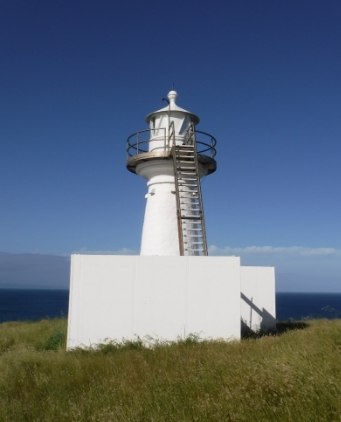
Figure 13. Cape St Albans tower with recent external ladder (© AMSA, 2017)
6.5 Proposals for change
Preventative maintenance works are carried out on the lighthouse to maintain its status as a working marine AtoN, and to assist in the site’s conservation.
A list of scheduled preventative maintenance work is identified within the latest available site inspection report. The information provided below was taken from this report.
Maintenance | Estimated date of work |
Structure paint | 2023 |
Lantern room paint | 2024 |
Reseal lantern glazing | 2024 |
LED array replacement | 2030 |
6.6 Potential pressures
A significant pressure that harnesses the potential to effect the Commonwealths heritage values of the place would be the obligation to remove or replace original fabric materials from the lighthouse owing to unavoidable and irreversible deterioration. At the time this plan was written, no current plans exist to remove or replace any original fabric materials from Cape St Albans Lighthouse. Any work proposed will be conducted in line with the heritage considerations and requirements of the EPBC Act.
6.7 Processes for decision-making
Processes for decision-making are required in the event of an incident that impacts the heritage values of the site. The following incidents are included due to their likelihood of occurrence at Cape St Albans Lighthouse.
Incident | Procedure |
Major project/maintenance works proposed | - Prepare Heritage Impact Statement on proposed modifications.
- Submit scope of works and Heritage Impact Statement to the DCCEEW and the Department for Environment and Water (SA) for review.
|
Damage to lighthouse’s fabric (heritage significance) | - AMSA or selected contractors assess extent of damage.
- Seek heritage advice on restoration of heritage fabric impacted.
- Identify possible loss of heritage value (at both state and Commonwealth level).
- Seek the appropriate approvals for restoration of heritage fabric impacted.
- Implement best-practice management of restoration work in keeping with the original character of the place.
- In the case of a loss of heritage value, prepare report for submission.
- Update record-keeping of incident and make available to relevant personnel.
|
Damage to lighthouse’s fabric (no heritage significance) | - AMSA or selected contractors to assess extent of damage.
- Identify possible impact on heritage fabric in any work carried out to restore fabric.
- Implement best-practice management of restoration work.
- Update record-keeping of incident and make available to relevant personnel.
|
Light upgrade | - Assess possible loss of heritage value in the event of an upgrade.
- If necessary, seek expert heritage advice on process of upgrade.
- If necessary, seek heritage approvals for the upgrade of light.
- Implement best-practice management of light upgrade work.
- Update record-keeping and make available to relevant personnel.
|
Modification to lighthouse such as adding of attachment | - Assess possible obstruction to light.
- Seek heritage approvals for attachment to tower.
- Monitor attachment and update record-keeping.
|
Unforeseen discovery of Aboriginal artefacts on-site. | - Immediate stop-work. Create temporary 'buffer' zone and allow no entry in zone until artefacts have been assessed by appropriate personnel.
- Notify Aboriginal Affairs and Reconciliation (Department of the Premier and Cabinet), and SA National Parks (Department of Environment and Water).
- Delay work on site until artefacts have been appropriately assessed and/or extracted and further investigations carried out in surrounding area.
- Update record-keeping of unforeseen discovery and make available to relevant personnel.
|
Divestment of lighthouse from AMSA | - Transfer ownership or control of heritage assets to appropriate stakeholder.
- Transfer relevant records and historical information held by AMSA to the appropriate authority.
|
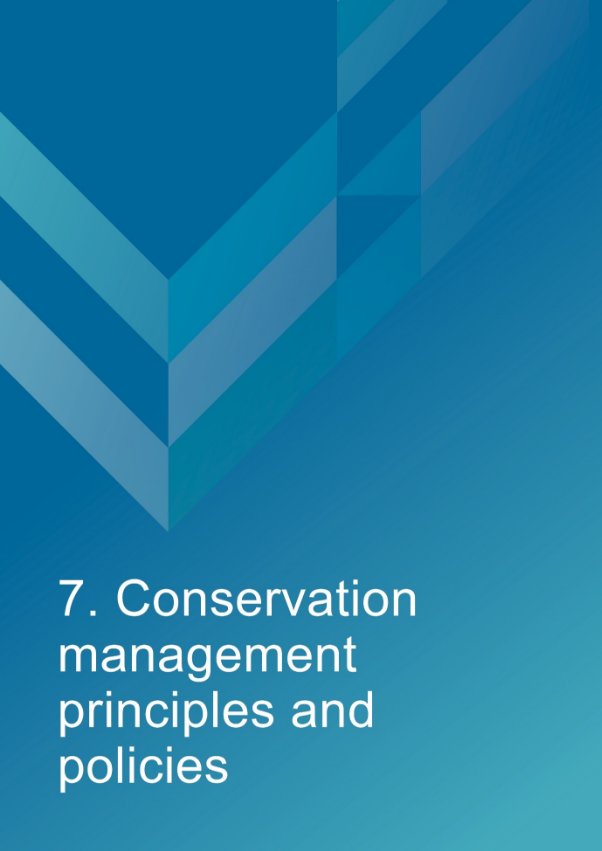
7 Conservation management principles and policies
Policies
Fabric and setting
Policy 1 – Protect and conserve the significant external and internal fabric of the lighthouse, including existing buildings, layout and setting.
AMSA’s main purpose is to facilitate the ongoing operation of the site as a marine AtoN while preserving the site’s heritage values. As part of a heritage monitoring program, Heritage Asset Condition Reports are produced for each site every two years to evaluate the condition of the heritage fabric and values. Routine servicing is also carried out by maintenance contractors. Regular written reports from these visits will be sent to Asset Management and Preparedness for review and any work requirements identified will be scheduled accordingly. Should for some unforeseen reason the site no longer be viable as a marine AtoN, ownership will be passed to an appropriate state of federal authority to ensure preservation of the heritage assets.
Implementation strategy:
- AtoN Maintenance contractor will continue scheduled periodic maintenance of the lighthouse and marine aids to navigation every 12 months to ensure condition is monitored for early warning of deterioration. Schedule must be approved by AMSA Asset Management and Preparedness.
- AMSA Asset Management and Preparedness to arrange for maintenance to be carried out on the lighthouse as required while continuing to operate as an AMSA marine aids to navigation.
- AMSA Asset Management and Preparedness to arrange for the replacement and upgrading of marine aids to navigation equipment in the lighthouse as required to meet AMSA’s service commitment, in a manner that preserves the original fabric of the lighthouse.
- AMSA Asset Management and Preparedness to maintain information on the heritage fabric of the lighthouse including any and all actions, treatments and inspection outcomes within the heritage fabric register. See section 4.1 for fabric register.
- AtoN Maintenance Contractor to continue scheduled heritage monitoring visits to Cape St Albans Lighthouse and review Heritage Asset Condition Reports.
- AMSA Asset Management and Preparedness to conserve all the fabric elements identified as significant in the heritage asset condition report.
- AMSA Asset Management and Preparedness to seek expert materials conservation advice when considering repair, restoration and reconstruction of historic fabric. The relevant local, state and federal heritage approvals must be sought prior to repair, restoration and reconstruction.
- AMSA Asset Management and Preparedness to assess any development proposals to surrounding area for possible impacts on the heritage values of Cape St Albans Lighthouse, and liaise with the appropriate state or federal heritage authorities.
- AMSA AtoN Heritage Coordinator to conserve the distinctive character of the lighthouse by collecting photographic evidence and historical documentation of the original fabric.
Uses
Policy 2 – Install and operate equipment in the lighthouse, so it continues to function as an effective marine AtoN, in such a way as to impose the least possible harm to the significant fabric.
Cape St Albans Lighthouse’s use as a working marine AtoN is of high priority. Carrying out maintenance, including upgrades to navigational equipment, is necessary to its function and continued marine safety along the SA coast. In the event of the installation or upgrade to AtoN equipment, proper precaution will be taken to ensure the least possible harm is done to significant fabric.
Implementation strategy:
- AtoN Maintenance Contractor to monitor Cape St Alban’s AtoN equipment every 12 months and propose maintenance in the instance of necessary installation or removal. Proposed maintenance is to be approved by AtoN Asset Management and Preparedness.
- AtoN Maintenance Contractor and AMSA Asset Management and Preparedness to outline all possible risks to significant fabric (external and internal) associated with the installation, removal and operation of navigational equipment.
- AMSA Asset Management and Preparedness to ensure works carried out are those that ensure the least possible harm to significant fabric.
- AMSA Asset Management and Preparedness to seek expert heritage conservation advice on best practice management of the site during installation, removal and operation of AtoN equipment.
Policy 3 – Monitor possible impacts to the site resulting from tourism and control appropriate access to the lighthouse for contractors and visitors.
Cape St Albans Lighthouse is not currently open as a tourist site and access inside the lighthouse is restricted to authorised personnel, such as contractors and AMSA employees. AMSA personnel and contractors require easy access inside the lighthouse tower for periodical site visits to carry out inspections and routine maintenance.
Implementation strategy:
- AtoN Maintenance contractor to ensure control on access to all buildings within the Commonwealth curtilage is maintained by periodically inspecting restricted access areas on the precinct during maintenance visits every 12 months.
- AtoN Maintenance Contractor to inspect lighthouse for signs of wear and tear during yearly maintenance visit, and note changes in Heritage Asset Condition Report.
- AMSA Asset Management and Preparedness to ensure access to the lighthouse complies with workplace health and safety measures.
- AMSA Asset Management and Preparedness to ensure contractors are made aware of the heritage values of the lighthouse.
- AMSA Asset Management and Preparedness to ensure access to site is available for Traditional Custodians to maintain cultural traditions.
Interpretation
Policy 4 – Accurate and relevant interpretation of the history and significance of the place should be made available to site users/visitors and for offsite external research.
AMSA will continue to make information available through the maintenance of site interpretive signage and its website.
Implementation strategy:
- All relevant information concerning the history and significance of the place will be checked for accuracy and updated appropriately.
- Information will be primarily presented in online resource files accessible to both relevant personnel and the general public. On-site interpretative signage will be utilised where possible.
- This information will be maintained and updated in accordance with changes to the history and significance of the place.
Management
Policy 5 – AMSA will continue to conserve the lighthouse in accordance with Commonwealth heritage listing requirements.
For works requiring heritage approval, AMSA will obtain permission from any relevant state or federal authorities. Continuous and as-needed conservation works will be undertaken as required.
Implementation strategy:
- Liaise with the relevant Commonwealth and State heritage agencies when proposing work on the site.
- Approval in writing from the relevant Commonwealth and State heritage authorities must be granted for any proposals for development.
Policy 6 – The cultural significance of the lighthouse will be the basis for deciding how to manage it.
The heritage values or cultural significance of the place must be conserved. This heritage management plan includes relevant background information to support this policy (see ‘Section 3 History’).
Implementation strategy:
- Conserve the lighthouse to protect its heritage values (cultural significance).
- When possible, strive to maintain the original fabric of the lighthouse.
- Use the Burra Charter as the primary guide for treatment of fabric.
- Engage appropriately qualified heritage consultants when making decisions regarding impact on heritage values.
- Assess impacts on the heritage values of the place when considering proposed alterations or adaptations.
Policy 7 – Monitor, review and report the Commonwealth heritage values of the lighthouse every five years or sooner if major changes to the lighthouse occur.
The Commonwealth heritage values of the lighthouse are to be monitored and reported on a regular basis. A Heritage Asset Condition Report is updated for Cape St Albans Lighthouse every two years. The report records historical information, condition, and maintenance requirements for fabric within the lighthouse to ensure a gain and/or loss of heritage value is identified.
Implementation strategy:
- AMSA Asset Management and Preparedness to regularly monitor the lighthouse for possible impacts on the identified Commonwealth heritage values.
- AMSA Asset Management and Preparedness to review the current Commonwealth heritage values at least once every five years and assess any gain or loss of values.
- This review must be undertaken in the event of any major alterations to the lighthouse.
- AMSA Asset Management and Preparedness to report any changes to the Commonwealth heritage values of the lighthouse to the DCCEEW (Heritage Branch).
- AMSA Asset Management and Preparedness to update AMSA’s heritage strategy and this plan to reflect any changes identified.
- AMSA AtoN Maintenance Contractor to review and update Heritage Asset Condition Report biennially.
Policy 8 – Maintain historical, management and maintenance records within AMSA and make available these records.
As part of the proper process for managing change in significant places, the Burra Charter points out the importance of making records before any change, and advocates placing records in a permanent archive and making them available where this is appropriate. AMSA’s collection of records, which include documents pertaining to heritage intervention, management and maintenance, are subject to this process. Heritage Asset Condition Reports are routinely generated for each heritage lighthouse and stored in AMSA’s record-keeping system. AMSA will continue to practice such processes via records management systems (RMS).
Implementation strategy:
- AMSA to maintain, review and update records through existing AMSA RMS as required.
- AMSA to ensure records are made available to the relevant personnel and parties as required.
Policy 9 – Develop and provide appropriate training and resources to all relevant AMSA staff, contractors and licensees.
In order to ensure best practice management of AMSA-operated lighthouses, all staff, contractors and licensees are required to have access to the appropriate training and resources in order to provide best practice conservation of the site.
Implementation strategy:
- Provide staff, contractors and licencees access to up-to-date versions of the AMSA heritage strategy, heritage management plans and fabric registers.
- When funds are made available, AMSA Asset Management and Preparedness staff will undertake a relevant induction to ensure comprehension of the Commonwealth heritage and EPBC Act statutory requirements.
- Contractors engaged with heritage sites will undertake appropriate training to ensure comprehension of the Commonwealth heritage and EPBC Act statutory requirements.
- AMSA representatives will attend Commonwealth-run heritage workshops, programs and conferences for up-to-date information on statutory requirements and best-practice management of sites of national and state heritage significance.
- All current and incoming tour guides operating within AMSA lighthouses will be required to take the lighthouse tour guide safety induction e-learning module once every two years to stay informed on heritage values, visitor safety and lighthouse duty-of-care.
Policy 10 – Use contractors and service providers with appropriate experience.
AMSA is to ensure parties carrying out work have appropriate knowledge and use effective methods to ensure conservation of the lighthouse.
Implementation strategy:
- Engage staff and contractors with the relevant experience and expertise concerning conservation of the lighthouse.
- Develop and provide the appropriate training on heritage conservation matters for AMSA Asset Management and Preparedness staff and other relevant parties who hold responsibility for heritage management.
Policy 11 – Seek heritage advice and apply best heritage practice.
AMSA will continue to use in-house heritage expertise, external consultancy, or a combination of both as required, in order to successfully apply best heritage practice. Should in-house heritage expertise be limited in responding to a requirement, external heritage expertise will be engaged to address the issue.
Implementation strategy:
- Apply in-house heritage expertise when required.
- Use tools such as the Burra Charter and Working Together: Managing Commonwealth Heritage Places[xxxviii] to measure the likely impact of proposals.
- Seek external heritage expertise in the event of limited in-house capability.
Policy 12 – Appropriate protocol in the event of unforeseen discoveries or disturbances of heritage within the AMSA site.
AMSA’s scope of work rarely involves excavation. Should such work need be undertaken, AMSA will implement a suitable discovery plan and seek advice from suitably qualified personnel as required. In the event of any unforeseen discovery or disturbance of heritage-related items on the AMSA site, notification to the appropriate organisation will occur in accordance with the conditions of the discovery plan. This plan will also be updated accordingly.
Note: In most cases, the Commonwealth curtilages are limited to the immediate vicinity of the lighthouse and therefore this scenario is not anticipated as a likely occurrence.
Implementation strategy:
- Contact SA National Parks (DEW) and SA Aboriginal Affairs and Reconciliation (DPC) in the event of an unforeseen discovery/suspected discovery.
- Seek appropriate heritage advice and apply best practice in the event of unforeseen discoveries/disturbances.
Policy 13 – Make this heritage management plan available to all persons involved in decision-making on the management of the lighthouse and its setting.
The plan will be made available to all personnel intrinsic to management of the lighthouse and its setting, for example AMSA maintenance contractors, staff and other relevant parties.
Implementation strategy:
- Provide links to this plan via the AMSA publicly accessible website.
- Provide copies to all relevant personnel and parties.
Future developments
Policy 14 – Adaptation of the place using methods or processes that minimise impact on heritage values and significance in accordance with the Burra Charter principles.
It is likely that over time the lighthouse will house new equipment as technology changes and improves. The Burra Charter principles will be used as the basis for decision-making.
Implementation strategy:
- Assess the likely impacts of changes on the heritage values and significance of the place.
- Preserve the original fabric of the place and do only what is necessary for the continued use and care of the place.
- Engage expert heritage advice and use the Burra Charter in adapting the place.
Policy 15 – When required, engage with adjacent landowners to maintain an appropriate setting for the lighthouse in its visual and natural context.
Any changes to the surrounding land, or Commonwealth curtilage, requires careful consideration. AMSA will liaise with all adjacent landowners in the event of any proposed changes that may affect the setting and attempt to influence a positive outcome.
Implementation strategy:
- AMSA Asset Management and Preparedness to engage with adjacent landowners through consultation when changes are proposed regarding the wider visual and natural context.
Policy 16 – In the event of adaptive re-use or divestment (an instance(s) which would no longer place the lighthouse under AMSA control), AMSA will strive to ensure the Commonwealth heritage values of the site are recognised and preserved.
In the event Cape St Albans Lighthouse is no longer identified as a working AtoN and ownership is passed to another State or Federal authority, AMSA will ensure this process is conducted in line with section 341ZE of the EPBC Act.
Implementation strategy:
- All available heritage information within AMSA’s collection, including this heritage management plan, will be shared with the relevant parties to ensure the Commonwealth heritage values of the site are recognised and preserved.
Community Involvement
Policy 17 – Consult with Traditional Custodians and community stakeholders in the preparation of the management plan.
AMSA will give Traditional Custodians and the wider community, as well as the general public, an opportunity to review and comment on this management plan through a public consultation process.
Implementation strategy:
- Undertake community consultation when preparing the heritage management plan in accordance with EPBC Regulations.
- Seek advice from Traditional Custodians and refer to Engage Early—Guidance for proponents on best practice Indigenous engagement for environmental assessments under the Environment Protection and Biodiversity Conservation Act 1999 (EPBC Act).[xxxix] to guide consultations.
Policy 18 – Manage and record sensitive information appropriately.
Sensitive information may be received by AMSA during consultation with stakeholders and the general public. This information will be handled in-line with AMSA’s privacy policy.
Implementation strategy:
- AMSA will record, store and manage sensitive information in-line with its privacy policy.
- No sensitive information will be included in draft or published heritage management plans.
Review
Policy 19 – Review this plan within five years of its adoption or sooner if major changes are needed.
This plan will be reviewed every five years. This review should:
- assess the content of the plan.
- determine its effectiveness in protecting the identified heritage values.
- provide any necessary recommendations for updating or re-writing of the plan. If major changes occur at the site in the interim, this plan will be reviewed and updated earlier than the specified five years.
Implementation strategy:
- AMSA Asset Management and Preparedness to review this heritage management plan at least five years after its adoption.
- AMSA Asset Management and Preparedness to review and update this heritage management plan in the event of a major change to the lighthouse.
- AMSA Asset Management and Preparedness to summarise changes implemented within updated plan.
- AMSA Asset Management and Preparedness to submit revised plan for approval.

8 Policy implementation plan
8.1 Plan and schedule
Key Issue | Management action/task | Policies | Responsibility | Priority | Timeframe |
Conservation and preservation | Conserve the lighthouse. | 1, 2, 3, 5, 6, 10, 11, 14 | AMSA, Asset Management and Preparedness | High | Ongoing |
Review the heritage management plan every five years. | 18 | AMSA, AtoN Heritage Coordinator | Medium | 2028 (5 year following registration) |
Make this plan available to all relevant personnel. | 7, 13 | AMSA, AtoN Heritage Coordinator | High | Ongoing |
Liaison dealings | If applicable, ensure communication is maintained with adjacent landowners. | 15 | AMSA, Asset Management and Preparedness | Medium | As required |
Consult with Traditional Custodians and the wider community in preparing the management plan. | 17 | AMSA, AtoN Heritage Coordinator | Medium | As required |
Heritage values | Review the Commonwealth heritage values every five years. | 7 | AMSA, AtoN Heritage Coordinator | High | 2028 |
Consider heritage values when proposing new planning and/or developments. | 5, 6, 7, 14 | AMSA, AtoN Heritage Coordinator and Project Managers | High | Ongoing |
Ensure process of re-use or divestment of the site recognises and preserves heritage values. | 16 | AMSA, AtoN Heritage Coordinator | High | As required |
Conduct heritage monitoring site visit and review Heritage Asset Condition Report every two years. | 1, 7 | AMSA, Asset Management and Preparedness | High | Once every two years (ongoing) |
Staff and community awareness | Provide relevant training and awareness for management personnel (contractors and site-users). | 9 | AMSA, Asset Management and Preparedness | Medium | As required |
Ensure the availability of accurate and relevant information on the history and significance of the lighthouse for site-users and visitors. | 4 | AMSA, AtoN Heritage Coordinator | Medium | Ongoing |
Record-keeping/access | Maintain adequate record-keeping of historical, management and maintenance documents. Make these records available. | 8 | AMSA, Asset Management and Preparedness | High | Ongoing |
Expert heritage advice | Ensure knowledge and advice of heritage experts is used. | 10, 11 | AMSA, Asset Management and Preparedness | Medium | As required |
Lighthouse maintenance | Schedule periodic maintenance. | 1 | AMSA, Asset Management and Preparedness | High | Ongoing, reoccurring every 12 months |
The implementation of unforeseen discovery or disturbance processes in the event of an accidental discovery. | 12 | AMSA, Asset Management and Preparedness | Medium | As required |
Lighthouse access | Secure appropriate access to lighthouse for contractor and visitors. | 3 | AMSA, Asset Management and Preparedness | Medium | Ongoing |
8.2 Monitoring and reporting
As stipulated by Schedule 7A of the EPBC Regulations, the outlined implementation plan and associated policies listed above are required to be monitored and updated accordingly. The below review process timetable will be adhered to over the next five years:
Timeframe | Review step | Responsibility |
2026 | Plan’s half-life internal review: - Assess strengths and weaknesses of existing plan
- Address any known impact to the lighthouse’s heritage values
| AMSA, Asset Management and Preparedness |
2028 | Plan’s full-life review: - Consult with internal and external stakeholders on existing plan
- Prepare updated draft plan and consult with the Heritage Branch
- Submit reviewed plan to the Minister
| AMSA, Asset Management and Preparedness |
Other key actions in monitoring and reporting include:
- ensuring the implementation plan and policies are readily available for all relevant personnel
- delegating AMSA staff to periodically check the implementation plan is up-to-date and being utilised appropriately by the relevant personnel
- ensuring the timeframes outlined within the plan are followed
- delegating AMSA Response staff to review this plan and the associated policies at least every five years and determine whether its contents are relevant and effective in terms of continuing to conserve the place.

Appendix 1. Glossary of heritage conservation terms
The Burra Charter, from its first version (1979) and its current version (2013), defined a set of terms that have since been widely adopted in Australian heritage conservation practice.
Where the following terms are used in this heritage management plan, the particular meanings defined in the charter are intended. The definitions are quoted from Article 1 of the Burra Charter.
Adaptation means modifying a place to suit the existing use or a proposed use.
Associations means the special connections that exist between people and a place.
Compatible use means a use which respects the cultural significance of a place. Such a use involves no, or minimal, impact on cultural significance.
Conservation means all the processes of looking after a place to retain its cultural significance.
Cultural significance means aesthetic, historic, scientific, social or spiritual value for past, present or future generations. Cultural significance is embodied in the place itself, its fabric, setting, use, associations, meanings, records, related places and related objects. Places may have a range of values for different individuals or groups.
Fabric means all the physical material of the place including components, fixtures, contents, and objects.
Interpretation means all the ways of presenting the cultural significance of a place.
Maintenance means the continuous protective care of a place and its setting. Maintenance is to be distinguished from repair which involves restoration or reconstruction.
Meanings denote what a place signifies, indicates, evokes or expresses to.
Place means a geographically defined area. It may include elements, objects, spaces and view. Place may have tangible and intangible dimensions.
Preservation means maintaining a place in its existing state and retarding deterioration.
Reconstruction means returning a place to a known earlier state and is distinguished from restoration by the introduction of new material.
Related object means an object that contributes to the cultural significance of a place but is not at the place.
Related place means a place that contributes to the cultural significance of another place.
Restoration means returning a place to a known earlier state by removing accretions or by reassembling existing elements without the introduction of new material.
Setting means the immediate and extended environment of a place that is part of or contributes to its cultural significance and distinctive character.
Use means the functions of a place, including the activities and traditional and customary practices that may occur at the place or are dependant on the place.
Appendix 2. Glossary of historic lighthouse terms relevant to Cape St Albans Lighthouse
A
Apron paving – the concrete paving surround the base of the lighthouse tower.
Astragal – the bars which support the glazing of a lantern. They may also support the roof. Simply a framing member between the glazing bars in the lantern glazing. In its true meaning an astragal is a moulding that has a rounded profile. In lanterns this is almost never the case.
B
Balcony – a walk way around the outside of the lantern, used for maintenance and (formerly, when lighthouses were manned) for observing ships. Principal parts are the balcony floor and the balcony balustrade. (Synonym: gallery deck).
Balcony floor – floor of the balcony. Cape St Albans’ balcony floor is of FRP mesh.
Balcony balustrade – a handrail together with its supports. The supports are called balusters. Simply a railing or wall on the outer perimeter of the balcony, to prevent people from falling off the balcony. Generally made of metal stanchions and rails – Cape St Albans’ balcony balustrade is recent stainless steel.
Balcony door – door in the lantern base to give access to the balcony. In AMSA lanterns two doors are sometimes fitted but only one is operational. (Synonym: parapet hatch, service room door). Cape St Albans has a 1914 Chance Brothers curved iron balcony door.
C
Candelas – International unit of measurement for the luminous intensity of a light.
Cast iron – a mixture of iron and carbon with a relatively high carbon content and a low melting point, produced directly from a blast furnace.
Chance Bros – English manufacturer of optical apparatus, lanterns, cast iron stairs, cast iron towers, and other lighthouse components. The Chance family established a glass-making business in Smethwick, England in 1824 and is often described as ‘near Birmingham’. The business was absorbed into the Pilkington group of companies in 1951 and now ceases to exist.
Character – pattern of flashes of light emitted by a lighthouse, designed to identify that particular lighthouse.
Copper – a red malleable metal of low resistivity.
I
Intensity – the strength of a light measured by candelas.
Iron – there were two common types of iron used in lighthouse construction; wrought and cast. Older lights will almost certainly contain these iron types. Wrought iron has been worked by hand and is an iron alloy with a very low carbon content in contrast to steel, it also has fibrous inclusions. Cast iron is iron which has been heated until it liquefies, and is then poured into a mould to solidify.
L
Lantern – the glazed enclosure, usually of cylindrical or polygonal shape, at the top of a lighthouse, which surrounds and protects the optical apparatus. It contains the optical apparatus, made up of the lantern roof, lantern glazing and lantern base sections.
Lantern floor – the level in a lighthouse at which the lantern is installed, and by which access may be gained to the optical system and to the inside and outside of the lantern glazing. The lantern floor is generally at or near the same level as the catwalk and cane be made from steel, concrete, or timber. Cape St Albans’ lantern floor consists concrete slab.
Lantern glazing – the middle section of the lantern, circular or polygonal in plan, between the lantern roof above and the lantern base below, made up of glass panes held in a framework of glazing bars. On the landward side there may be blank panels in place of glass, or other opaque construction. Types of lantern glazing include: flat & curved trapezoidal panes and curved diamond/triangular panes. Cape St Albans’ lantern glazing are curved, trapezoidal glass panes.
Lantern roof – the roof of the lantern. Usually made of copper sheeting over a framework of rafters.
Lens assembly – a transparent optically refracting element of glass. The surface is usually spherical in form.
Light source – electric bulbs now illuminate most lighthouses.
Lighthouse – the principal structure of a lightstation, generally made up of a lantern, balcony and tower.
Lightstation – a precinct containing a lighthouse structure and other related buildings, for example. Keepers’ cottages, store room, signal house.
O
Order – a shorthand expression of the size of an optical apparatus or lantern. At the time the system of orders was established, when kerosene burners were used, longer range lights needed larger burners, and larger burners needed lens assemblies of longer focal length to ensure a sharply defined beam. Thus in turn the lantern rooms were required to be larger to house these lens assemblies. AMSA historic lantern rooms range from 1st to 4th order.
P
Pedestal – part of the optical apparatus, consisting of a metal column or base standing on the balcony floor inside the lantern and supporting the lens assembly and light source. Some later Chance documentation (such as their tariffs 1908) also refer to the lantern base as a pedestal.
T
Tower – structure to support the lantern at a sufficient height above the ground. The most common types are the masonry tower, timber-framed tower, cast iron tower, and lattice tower. Cape St Albans’ tower is of 1908 rubble stone masonry.
Appendix 3. Table demonstrating compliance with the EPBC Regulations
Environment Protection and Biodiversity Conservation Regulations 2000 (Cth) Schedule 7A – Management Plans for Commonwealth Heritage Places |
Legislation | Satisfied within |
A management plan must: |
(a) Establish objectives for the identification, protection, conservation, presentation and transmission of the Commonwealth Heritage values of the place | Section 1 – Introduction |
(b) Provide a management framework that includes reference to any statutory requirements and agency mechanisms for the protection of the Commonwealth heritage values of the place | Section 1 – Introduction |
(c) Provide a comprehensive description of the place, including information about its location, physical features, condition, historical context and current uses | Section 2 – Cape St Albans Lighthouse site Section 3 – History Section 4 -– Fabric |
(d) Provide a description of the Commonwealth heritage values and any other heritage values of the place | Section 5 – Heritage significance |
(e) Describe the condition of the Commonwealth heritage values of the place | Section 5 – Heritage significance |
(f) Describe the method used to assess the Commonwealth heritage values of the place | Section 5 – Heritage significance |
(g) Describe the current management requirements and goals including proposals for change and any potential pressures on the Commonwealth heritage values of the place | Section 6 – Opportunities and constraints |
(h) Have policies to manage the Commonwealth heritage values of a place, and include in those policies, guidance in relation to the following: | |
i. The management and conservation processes to be used | Section 7 – Conservation management principles and policies (Policy 1, 2, 3, 5, 6, 10, 11, 14) |
ii. The access and security arrangements, including access to the area for indigenous people to maintain cultural traditions | Section 7 – Conservation management principles and policies (Policy 3) |
iii. The stakeholder and community consultation and liaison arrangements | Section 7 – Conservation management principles and policies (Policy 15, 17) |
iv. The policies and protocols to ensure that indigenous people participate in the management process | Section 7– Conservation management principles and policies (Policy 17) |
v. The protocols for the management of sensitive information | Section 7 – Conservation management principles and policies (Policy 18) |
vi. The planning and management of works, development, adaptive reuse and property divestment proposals | Section 7 – Conservation management principles and policies (Policy 16) |
vii. How unforeseen discoveries or disturbances of heritage are to be managed | Section 7 – Conservation management principles and policies (Policy 12) |
viii. How, and under what circumstances, heritage advice is to be obtained | Section 7 – Conservation management principles and policies (Policy 10, 11) |
ix. How the condition of Commonwealth heritage values is to be monitored and reported | Section 7- Conservation management principles and policies (Policy 5, 6, 7, 14) |
x. How records of intervention and maintenance of a heritage places register are kept | Section 7 – Conservation management principles and policies (Policy 7, 13) |
xi. The research, training and resources needed to improve management | Section 7 – Conservation management principles and policies (Policy 9) |
xii. How heritage values are to be interpreted and promoted | Section 7 – Conservation management principles and policies (Policy 4) |
(i) Include an implementation plan | Section 8 – Policy implementation plan |
(j) Show how the implementation of policies will be monitored | Section 8 – Policy implementation plan |
(k) Show how the management plan will be reviewed. | Section 7 – Conservation management principles and policies (Policy 19) Section 8 – Policy implementation plan |
Appendix 4. Cape St Albans current light details
CAPE ST ALBAN LIGHT - SA
(Established 1908)
IALA AVAILABILITY
CATEGORY: 2
PERFORMANCE 99%
CRITERIA
(AVAILABILITY):
POSITION: Latitude: 35° 48.2300'S
Longitude: 138° 07.5120'E
Datum: WGS84
BA LIST OF LIGHTS: Q 2110
DAYMARK: White masonry tower and lantern
HEIGHT OF DAYMARK: 9 metres
ARC OF VISIBILITY: 118 - 005 (247)
(TRUE BEARINGS
FROM SEAWARD)
COLOUR OF LIGHT: White
CHARACTER: Flashing 5.0 seconds
Flash: 1.0 seconds
Eclipse: 4.0 seconds
LENS: 250 mm focal radius drum lens
LIGHT SOURCE: Lamp: Sealite SL-LED-216-W
LANTERN: Chance Bros 5’8” diameter
STRUCTURE: White round masonry tower, 6 metres to base of lantern.
ELEVATION: 48 metres
RANGE: Nominal: 14 nautical miles
Geographical: 18.6 nautical miles
Endnotes

























































